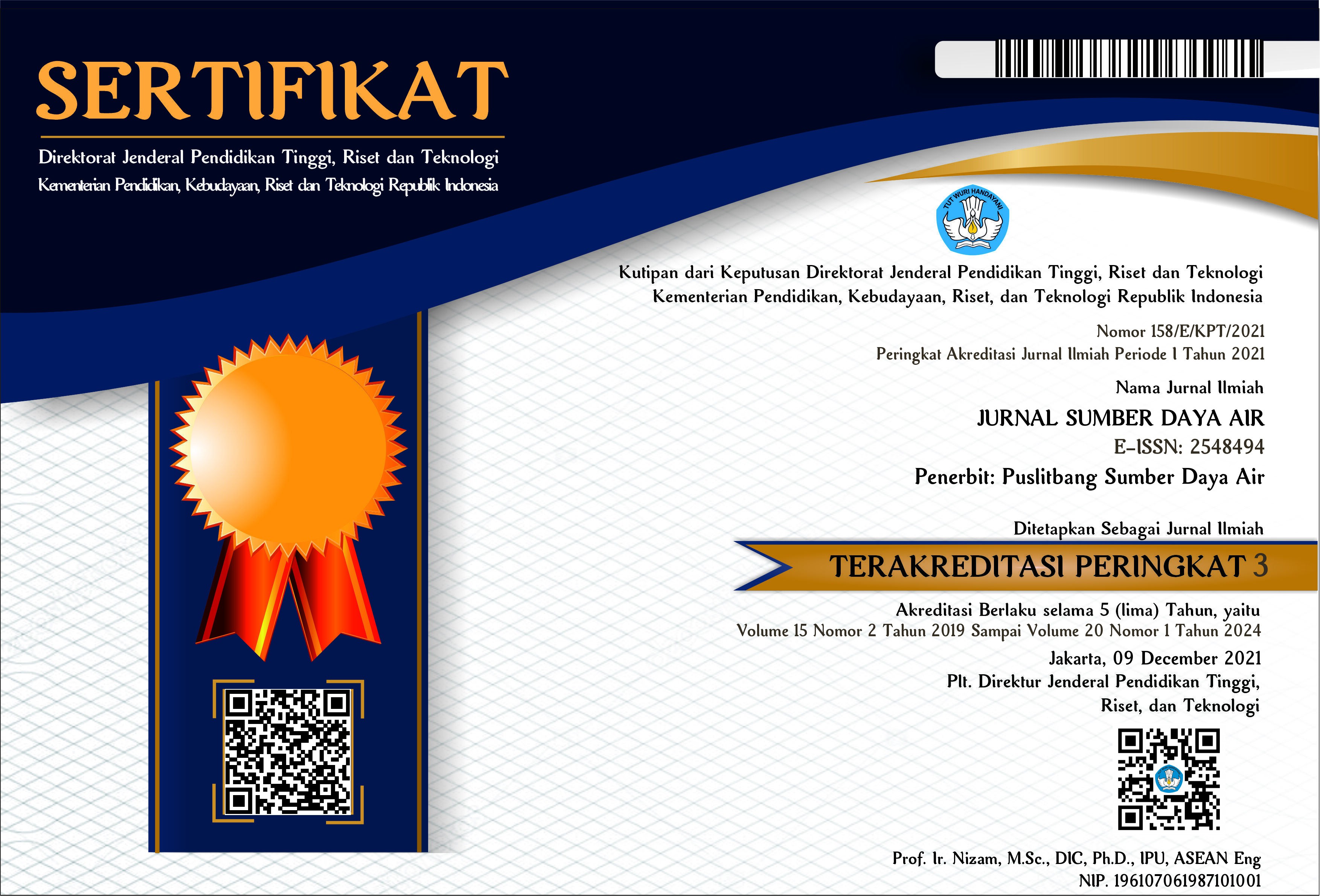Water scarcity : Review of water supply system in Bekasi Region
DOI:
https://doi.org/10.32679/jsda.v12i2.64Keywords:
Clean water, demand, supply, scarcity, piping systemAbstract
Imbalance of supply and demand is the beginning of a scarcity of clean water. To detect the occurrence of water scarcity needed calculation of water demand to estimating water source to be used. Water scarcity occurs due to natural factors associated with limited sources of raw water to water drinking, the system performance of water supply services are inefficient and increasing of water demand. The high level of leakage, inefficient processing, and low of coverage service from PDAM are performance factors that is causing water scarcity. Meanwhile, population growth and development of the region is demand side factor which led to the scarcity of water. Shortage of safe drinking water to the community caused by the condition of water management is not optimal. This is demonstrated by the leakage rate is still above the standard that tolerated (20%), a relatively small customer coverage is 15.69% of the population that has been underserved by the piping systems, idle capacity because of unoptimal instalation. Scarcity can anticipate with three ways: (1) increasing quantity and quality of raw water, (2) save the use of water and recycle waste water, (3) decrease of leakage, improve PDAM performance, and efficiency of water treatment.
References
Arbues F, Angeles M, Martinez R. 2003. Estimation of residential water kebutuhan:a state-of-the-art review. Journal of Socio-Economics 32 : 81–102.
Badan Perencanaan Pembangunan Daerah (BAPPEDA). 2013. Rencana Induk Pengembangan Air Minum. Bekasi: BAPPEDA.
Badan Pusat Statistik. 2010-2014. Kabupaten Bekasi Dalam Angka. Jakarta: BPS.
Biro Pusat Statistik (BPS). 2014. Survey Sosial Ekonomi Daerah (Suseda). Kabupaten Bekasi: Baappeda.
Bohmelt T, Bernaurer T, Buhaug H. 2014. Kebutuhan, Supply and Restraint: Determinants of Domestic Water Confict and Cooperation. Global Environmental Change 29 : 337-348.
Butler D, Farmani R, G Fu S. Diao, Astaraie-Imani. 2014. New Approach to Urban Water Management: Safe and Sure. 16 th Conference on Water Distribution System Analysis, WDSA 2014. Elsevier Ltd. 347-354.
Claudiu. 2012. Scarcity and Population. A Non-Malthusian Point Of View. WC-BEM 2012. Elsevier Ltd. 1115-1119.
Da-Ping Xia, Hong-Yu G. 2011. Discussion on Demand Management of Water Resources. Procedia Environmental Sciences 10 : 1173 – 1176.
David H. 2006. Analisa Kebutuhan Air Bersih Berbasis Masyarakat. Jurnal Teknosain 6: 76-87
Farley, M. Wyeth, G. Ghazali. et al. 2008. The Manager's Non-Revenue Water Handbook: A Guide to Understanding Water Losses. USAID.
Gizelis TI, Wooden A.E. 2010. Water Resources, Institition and Intrastate Conflict. Political Geography 29 : 444-453.
Gusdini, N. Purwanto M Y J. Murtilaksono, K. Kholil. 2015. Model Pemenuhan Kebutuhan Air Bersih Kabupaten Bekasi. IPB.
Holling, CS. 1996. Engineering Resilience Versus Ecological Resilience. Dans Engineering Within Ecological Constraints, de P. Schulze. National Academy of Engineering.
Jauad El Kharraz, Alaa El-Sadek, Ghaffour N, Mino E. 2012. Water scarcity and drought in WANA countries. ISWEE 11. Elsevier Ltd. 14-29.
Kharraza el Jaudad, alaa El-Sadekb, Noreddine Ghaffourc, Eric Minoa. 2012. Water Scarity and Drought in WANA Countries. ISWEE'11. Elsevier Ltd. 2012 : 14-29.
Lambert, AO. Brown, TG. Takizawa, M. Weimer D. A. 1999. Review of Performance Indicators for Real Losses For Water Supply System. Aqua: 227-237.
Matthew, R.A. Gaulin T. 2001. Conflict or Cooperation? The Social and Political Impacts of Resource Scarcity on Small Island States. Global Environmental Politics 1 : 48-70.
Neverre, N & Dumas, P. 2015. Projecting and Valuing Domestic Water Use at Regional Scale : A Generic Method Applied to Mediterranean at The 2060 Horozon. Water Resources and Economic Vol. 11 : 33-46.
Noerbambang, S. Morimura T. 1993. Perancangan dan Pemeliharaan Sistem Plumbing (ID). Pradnya Paramita.
Ricado MNV, Magalhaes PF, Antonio JPB. 2015. Performance measurement and Indicators for Water Supply Management: Review and International Cases. Renewable and Sustainable Energy Review 43 : 1-12.
Ricardo, M N. Paulo Magalhhaes. 2015. Performance Measurement And Indicators For Water Supply Management: Review And International Cases. Renewable and Sustainable Energy Review 43, 1-12.
Stamboui AB, Khiat Z, Flazi S, Tanemoto H, Nakajima M, Isoda H, et al. 2014. Trends And Challenges Of Sustainable Energy And Water Research In North Africa: Sahara Solar Breeder Concerns At Intersection Of Energy And Water. Renewable sustainable energy Rev 30: 912-922.
Suparyadi, E. 2008. Evaluasi Kinerja Forum Bina Lingkungan dalam Pengawasan dan Pengendalian Pencemaran Air Sungai, di Kecamatan Cikarang Barat Kabupaten Bekasi. Thesis. Program Pascasarjana Teknik Pembangunan Wilayah dan Kota. Semarang : Universitas Dipenogoro.
Water Research Commision (WRC). 2014. A completed WRC-funded project has successfully identified the important link between social water scarcity and water use. South Africa: Water Research Comission.
Wentz E A. 2007. Determinants of Small Area Water Consumption for The City of Phoenix, Arizona. Water Resource Manage 21: 1849-1863.
Downloads
Published
How to Cite
Issue
Section
License
The Authors submitting a manuscript do so on the understanding that if accepted for publication, copyright of the article shall be assigned to Jurnal Sumber Daya Air and Pusat Penelitian dan Pengembangan Sumber Daya Air as publisher of the journal.Copyright encompasses exclusive rights to reproduce and deliver the article in all form and media, including reprints, photographs, microfilms and any other similar reproductions, as well as translations. The reproduction of any part of this journal, its storage in databases and its transmission by any form or media, such as electronic, electrostatic and mechanical copies, photocopies, recordings, magnetic media, etc. , will be allowed only with a written permission from Jurnal Sumber Daya Air and Pusat Penelitian dan Pengembangan Sumber Daya Air.
Jurnal Sumber Daya Air and Pusat Penelitian dan Pengembangan Sumber Daya Air, the Editors and the Advisory International Editorial Board make every effort to ensure that no wrong or misleading data, opinions or statements be published in the journal.




















